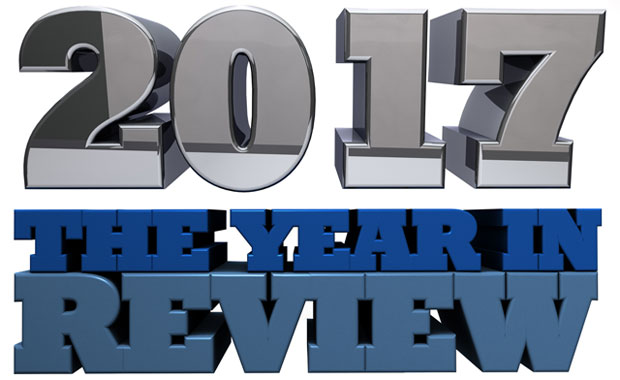2017 may be the year that developments in the tech world truly were overshadowed by other world events: deepening divisions in the United States and the looming threat of war with North Korea; numerous high-profile Hollywood players, TV personalities, politicians, journalists, business executives and others involved in sexual misconduct scandals; terrorist attacks in Europe and elsewhere; and the announcement of yet another royal wedding in the United Kingdom, to name just a few.
With all of that going on, it would be easy to overlook Apple’s introduction of another iPhone or Nintendo’s comeback with a hit video game console. The truth is that 2017 could be what sports teams often call “a rebuilding year.”
It’s not that there was a lack of exciting new tech — it’s just that nothing was a true game-changer or disrupter. Technology has become such an integral part of our lives that it is easy to forget that today’s smartphones are exponentially more powerful than the computers that helped get humans to the moon almost 50 years ago — and that a 50-inch flat-panel TV in the living room wasn’t always the norm.
No, 2017 wasn’t a year of innovation in smartphones, breakthroughs in streaming media, or even the debut of bigger, higher-resolution, or thinner TVs.
What 2017 may become remembered for is its foreshadowing of the technologies that will change our lives in years to come.
Internet of Things: More Promise Than Delivery
If there is a buzzword that didn’t buzz quite as much as the digiterati predicted, it is the “Internet of Things,” which has been on the cusp of being the next big thing for way too many years. In fact, the term actually was coined by Kevin Ashton of Procter & Gamble, and later MIT’s Auto-ID Center, way back in 1999.
In 2017, it remained mostly hype.
“IoT seems stuck, with an industry trying to leverage next year’s gear through last year’s supply chain,” said Jim Purtilo, associate professor in the computer science department at the University of Maryland.
“There are only just so many ways to sell to consumers, download media to them, or turn their house lights on and off,” he told TechNewsWorld.
“Where’s the innovation that turns this technology on its ear and convinces the broad market we can’t live without it?” Purtilo wondered.
On the other hand, “certain kinds of IoT — mainly industrial deployments and applications — mostly left the hype behind and began looking commercially sustainable,” said Charles King, principal analyst at Pund-IT.
“There’s still more than a little hype around the IoT category, especially when it comes to consumer- and home-focused products and services,” he told TechNewsWorld. Yet the size and need for associated professional services make industrial-focused solutions far more attractive to vendors.
That is why 2017 wasn’t the year of IoT and why it is unlikely that next year will be either.
“Until now, IoT vendors have mostly focused on building parts of a solution,” noted Rob Enderle, principal analyst at the Enderle Group.
“As we move into 2018, vendors like Amazon and Samsung on the consumer, and Dell and Cisco on enterprise, will be shifting to providing complete end-to-end solutions,” he told TechNewsWorld.
The potential of IoT is there — as are the rewards for those who finally bring it to the masses.
“Whenever it emerges, it will be the holy grail of data mining for companies, since however much value they skim by convincing us to carry around mobile trackers and share all our documents, the value pales in comparison to what companies will reap when they can track our moment-to-moment activity in our homes,” Purtilo pointed out.
Machine Learning: Head of the Class
Several high-profile figures — including Stephen Hawking and Elon Musk, among others — expressed fears that artificial intelligence and machine learning could take control of our very creations. The concern is that sci-fi films such as The Terminator could become self-fulfilling prophecies.
AI and machine learning didn’t signal the end of mankind in 2017, but they may have advanced the end of privacy.
“Artificial intelligence is woven into an increasing array of online services, and the companies using it are not asking for opt-in permission or, indeed, permission at all,” said Steve Blum, principal analyst at Tellus Venture Associates.
“Web services, mobile apps, and point-of-sale and similar devices are recognizing who we are, or at least who we might be, and proactively tailoring responses, often without us even asking,” he told TechNewsWorld.
“If you’re not paying particular attention, it seems like simple convenience; you don’t have to work as hard to get what you want, even though you often end up with what an AI system thinks you should want,” Blum added. However, “if you are paying attention, it can be very spooky.”
At the same time, machine learning may make it easier to tie our devices together. In other words, for IoT to work, we need better machine learning.
“AI was the serious growth industry in the last year,” suggested the University of Maryland’s Purtilo.
It built on big data’s successes, which set the stage and gave people more to work with for training machines in one or another application. Also, better tools have dropped the entry barrier to innovation significantly.
“In the near term, this also means we’ll see a lot of less-than-stellar applications of ML techniques as more people try it without knowing how to do it right,” Purtilo added, “but in the long run, that is healthy; it means market forces have something to work out.”
One area where it is being worked out is in autonomous vehicles or self-driving cars. 2017 wasn’t the year that the cars did the driving, but machine learning played other roles.
“The sharing economy meets machine learning and AI in 2017, where AI has replaced the dispatcher,” noted Josh Crandall, principal analyst at Netpop Research.
“In transportation, efficiency is everything, and it’s not a surprise that we’re seeing machine learning and artificial intelligence starting to make a noticeable impact on operations,” he told TechNewsWorld. “Lyft and Uber are utilizing machine learning to schedule pickups so that drivers are never waiting for their next fare.”
AR/VR: More Buzz Than Reality
If there was a true “buzzword” that gained steam in 2017, it may have been “augmented reality,” which melds actual reality with virtual reality. However, the promise of what it could offer largely has remained more hype than delivery.
“AR/VR is notable for what didn’t happen, which was to find those breakout apps that the area needs to attract the broader market,” said Purtilo.
“The industry sees a steady expansion in the use of AR technology in manufacturing, just as VR sees steady demand among technologists looking for novel visualization tools — but neither is yet a game changer,” he added. “This year, we just saw more of the same — maybe with signs of impatience that the big promises haven’t yet been fulfilled.”
Personal Home Assistant: Listen Up
2017 wasn’t the year of robot butlers or maids, but digital assistants made significant headway. When Saturday Night Live and South Park offer satirical takes on a product trend, it is truly a sign that it has gone mainstream. South Park’s episode reportedly even affected actual units in viewers’ living rooms.
“Personal home assistants — Alexa from Amazon and Google Home — were among the biggest breakout hits for new technology in 2017,” said Netpop’s Crandall.
“Alexa’s simple to use voice-interface and ever-increasing set of ‘skills’ have opened up a new market for smart home appliances that were often too demanding for consumers to configure and manage,” he added.
“Voice recognition technology reached the point where it can replace manual data and command entry on a routine basis,” noted Tellus’ Blum.
“However, the more useful it becomes, the more it is tied to massive artificial intelligence platforms, which gives Amazon, Google, and Apple a huge advantage,” he added. “Those three companies are positioning themselves to be the front end for all of our interactions with the digital realm.”
Cybersecurity: The Hacks Kept Coming
The past year didn’t see a major hack leading the nightly news — there was no massive cyberattack on a government agency like the 2015 breach of the Office of Personnel Management.
Also, cyberattacks have become so common that perhaps even when a major one occurs, it isn’t as newsworthy.
“The interesting trend of 2017 was ransomware,” observed futurist Michael Rogers.
“Total damages went from (US)$325 million in 2015 to $5 billion in 2017,” he told TechNewsWorld.
“A startup with that kind of growth would be on the cover of Fortune, and we’d be waiting for the IPO,” Rogers suggested.
“On the plus side, thousands of people learned how to use bitcoin, thanks to the educational how-to-pay-ransom video embedded in most versions of ransomware,” Rogers added.
“The trend here is that regardless of good intentions and heightened awareness, the world is not keeping up with cybersecurity,” he warned.
Perhaps next year.























































